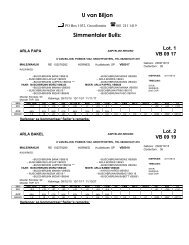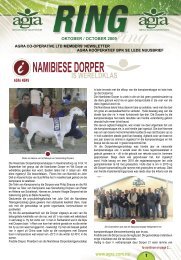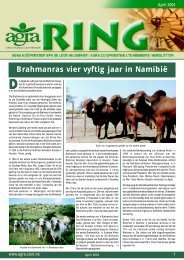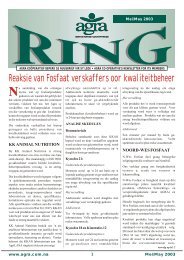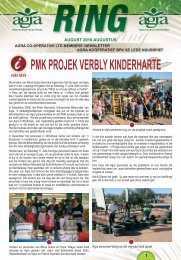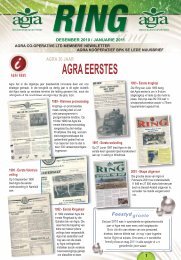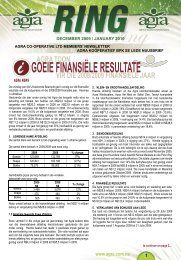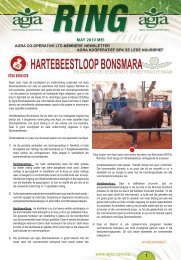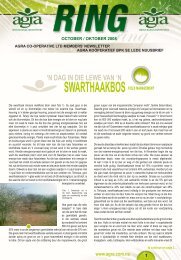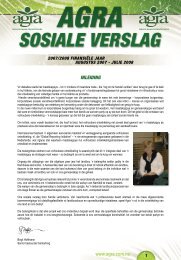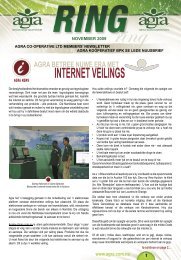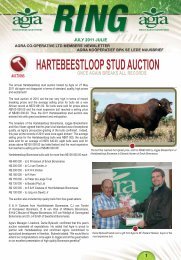namibië se nuwe arbeidswet - Agra
namibië se nuwe arbeidswet - Agra
namibië se nuwe arbeidswet - Agra
You also want an ePaper? Increase the reach of your titles
YUMPU automatically turns print PDFs into web optimized ePapers that Google loves.
continued from page 17…<br />
injection is the most common cosmetic operation and Botox cosmetic<br />
providers include dermatologists, plastic surgeons cosmetic physicians<br />
and medical spas.<br />
2. Tetanus<br />
(“Klem-in-die-kaak” Afr., „Wundstarrkrampf“ Ger.)<br />
This is another clostridial di<strong>se</strong>a<strong>se</strong> giving ri<strong>se</strong> to a <strong>se</strong>rious intoxication<br />
by a neurotoxin, tetanospasmin, causing the rigidity of muscle spasms,<br />
resulting in a spastic paralysis. The toxin is produced by the spore<br />
forming bacterium Clostridium tetani. Since the symptoms are quite<br />
distinctive and typical, tetanus is usually easy to recognize, especially<br />
in the advanced stage. It was described by Hippocrates in the early<br />
records of human medical history and even in modern day human<br />
and veterinary medicine it remains an important di<strong>se</strong>a<strong>se</strong> that requires<br />
prophylactic vaccination. In developing countries it is a <strong>se</strong>rious public<br />
health problem, with 50,000 fatalities being reported each year.<br />
Sporadic ca<strong>se</strong>s or outbreaks of tetanus occur in humans and animals<br />
throughout southern Africa.<br />
The di<strong>se</strong>a<strong>se</strong> is very diffi cult to treat and by the time symptoms occur, it is<br />
too late and the animal usually dies. Susceptibility varies considerably<br />
among different mammal and bird species. Humans and hor<strong>se</strong>s are the<br />
most <strong>se</strong>nsitive to the effects of the toxin, followed in order of <strong>se</strong>nsitivity<br />
by sheep and goats, mice, rats, rabbits, monkeys, dogs, cats, pigs and<br />
cattle, while birds are most resistant.<br />
Tetanus occurs wherever animals are farmed. The spores produced<br />
by Clostridium tetani are pre<strong>se</strong>nt in soil, dust and the faeces of most<br />
herbivores. The fact that C. tetani is part of the normal intestinal fl ora<br />
of many animals plays an important role in the dis<strong>se</strong>mination of the<br />
organism. Tetanus occurs when wounds, especially deep penetrating<br />
wounds such as tho<strong>se</strong> cau<strong>se</strong>d by a nail penetrating a hor<strong>se</strong>s’ hoof,<br />
are contaminated by Clostridium tetani. Necrotic or dead tissue in<br />
the<strong>se</strong> wounds creates ideal conditions for the organisms to grow. The<br />
bacteria multiply rapidly in the wounds and produce the toxin which is<br />
then absorbed into the body. The bacteria do not invade the body and<br />
will remain in the wound and produce toxin as long as conditions are<br />
favourable. The toxin spreads via the nerves or the lymph and blood<br />
streams to the spinal cord and the brain. The bacteria can also cau<strong>se</strong><br />
infection of the umbilical stump (navel) in the newborn. Other wounds<br />
commonly associated with tetanus are castrations with rubber rings,<br />
tail dockings, shearing wounds, injections with contaminated needles,<br />
bite wounds, eruption<br />
of permanent teeth,<br />
compound fractures of<br />
bones and frostbite. In<br />
cattle it rarely occurs<br />
after penetration of the<br />
reticulum by a foreign<br />
body like a wire and as<br />
a result of retention of<br />
the placenta after birth.<br />
Sometimes wounds may<br />
already have healed for<br />
some time, before the<br />
on<strong>se</strong>t of symptoms.<br />
Wounds cau<strong>se</strong>d by rubber ring-castration can lead to Tetanus.<br />
18<br />
www.agra.com.na<br />
The incubation period of tetanus can be as short as three days, but<br />
usually varies from one to three weeks after infection has occurred.<br />
Initially, all voluntary muscles show increa<strong>se</strong>d stiffness, followed by<br />
tetanic spasms all over the body particularly when affected animals are<br />
disturbed by handling, touching or noi<strong>se</strong>. Restricted jaw movements,<br />
spasms of the nostrils and tail, prolap<strong>se</strong> of the third eyelid, increa<strong>se</strong>d<br />
<strong>se</strong>nsitivity to touch and stiffness of hindlegs are other common signs.<br />
Death follows within 12 – 72 hours, but the cour<strong>se</strong> may be prolonged.<br />
In very exceptional ca<strong>se</strong>s some animals may recover. In sheep and<br />
goats lambs do not suckle, have a grinning facial expression due to<br />
contraction of facial muscles, and hold their heads high and their legs<br />
wide apart. Bending of the joints becomes virtually impossible and<br />
animals move with great diffi culty. If the animals are startled, they fall<br />
down on their side and go into spasms, bending their neck backwards<br />
with the legs stiffened and outstretched. Death occurs after three to ten<br />
days in 100% of animals showing symptoms.<br />
Spastic paralysis due to Tetanus.<br />
In hor<strong>se</strong>s the clinical signs are characteri<strong>se</strong>d by fl ared nostrils, a<br />
sawhor<strong>se</strong> stance, <strong>se</strong>vere muscle spasms, clamping of the jaws<br />
(trismus) and prolap<strong>se</strong> of the third eyelids. When trismus occurs,<br />
the mouth is held tightly shut and all attempts to <strong>se</strong>parate the jaws<br />
are generally unsuccessful. Other signs include colic, retention of<br />
urine inability to feed off the ground, twisted neck, sweating, diffi cult<br />
breathing, hyperaesthesia, and anxious facial expression. The ears<br />
are erect and the tail is very rigid and usually held sideways. Saliva<br />
can dribble profu<strong>se</strong>ly from the mouth. Affected animals eventually go<br />
down on their side and go into spasms. The muscle spasms occur<br />
with greater frequency and have longer duration as death approaches.<br />
The clinical signs in cattle include an extended head, a rai<strong>se</strong>d tail,<br />
a sawhor<strong>se</strong> stance, prolap<strong>se</strong> of the third eyelids, ruminal stasis,<br />
constipation, marked stiffness and in some animals bloating. There is<br />
also pronounced dullness and depression. Prognosis of an animal with<br />
tetanus is generally very poor and it is most unfavourable, once signs<br />
of tetanic spasms occur. If a wound is pre<strong>se</strong>nt it should be debrided,<br />
cleaned, disinfected and locally infi ltrated with Penicillin G. Penicillin<br />
G should also be given systematically and the animal kept very<br />
quiet in a dark stable and treated with muscle relaxants. Circulating<br />
tetanospasmin can be neutrali<strong>se</strong>d by administration of an antitoxin,<br />
but this is not available in this country for animal u<strong>se</strong>, only for human<br />
u<strong>se</strong>. Administration of antitoxin will only neutrali<strong>se</strong> the toxin pre<strong>se</strong>nt in<br />
the blood circulation. The antibodies in the anti<strong>se</strong>rum cannot cross the



